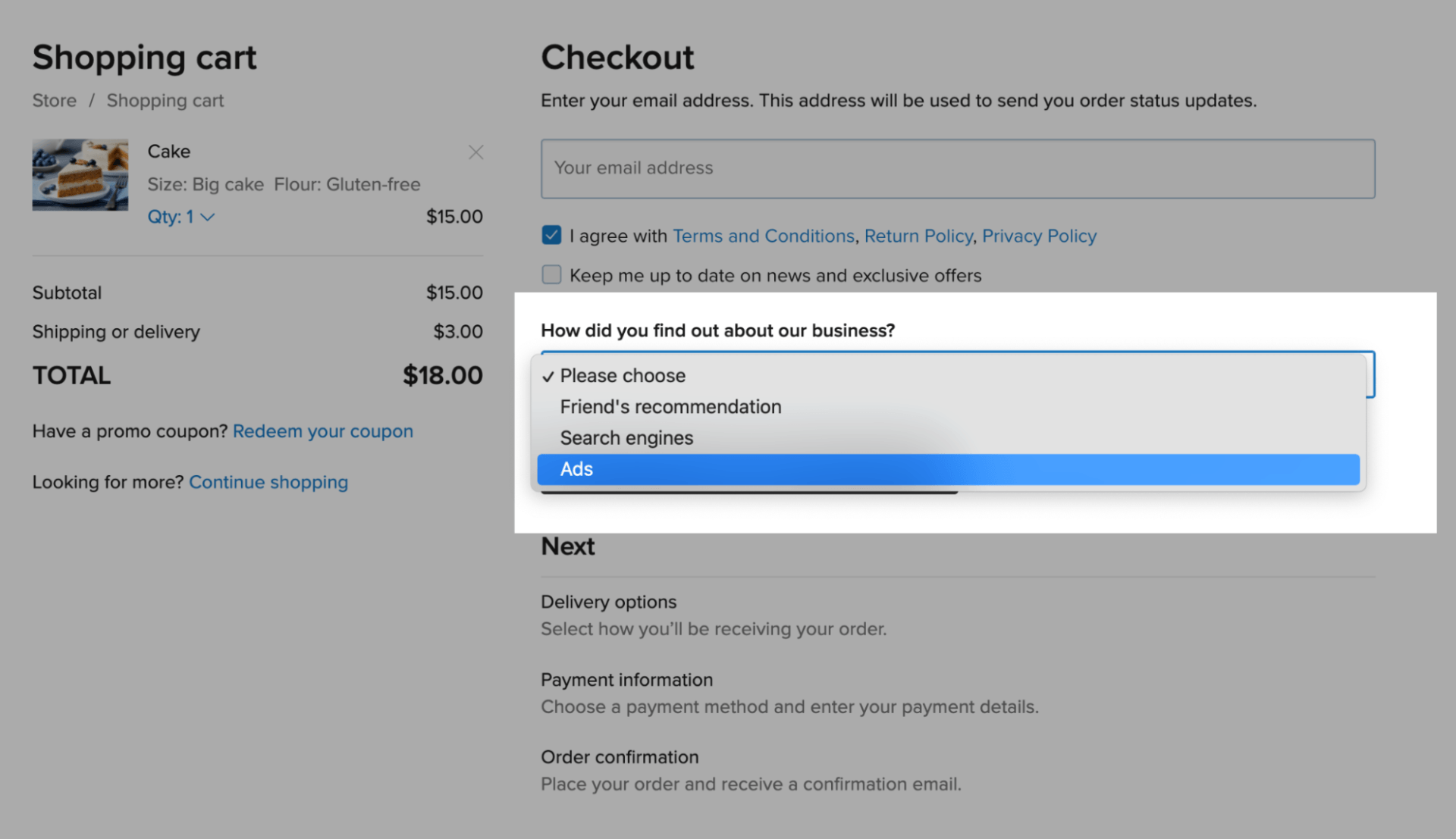How to Customize Online Checkout to Improve Shopping Experience & Sales

The checkout page is crucial when it comes to online selling. This is where customers finalize their purchase, enter their payment and shipping information, and hit that precious “Buy” button.
However, almost 70% of online shoppers abandon checkout without a purchase. One of the main reasons is an inconvenient checkout process, which can be caused by various mishaps. One of them is when your checkout is not customized to meet your customers’ needs.
In this article, we give you a few tips on how to customize your store’s checkout to improve the shopping experience in your store and increase sales.
The First Step to a Converting Checkout
The number of abandoned carts has been rising in recent years. This means that ecommerce companies are having more and more trouble converting customers.

Online shopping cart abandonment rate worldwide, 2006-2020 (Source: Statista)
According to one study, 17% of US online shoppers have abandoned an order solely due to an overly long or complicated checkout process.
First and foremost, you need to keep your online checkout simple. The fewer steps there are in the checkout process, the better. That’s why it’s crucial to choose an ecommerce platform that provides online sellers with a customer-friendly checkout.
VIV provides online merchants, and their customers, with a convenient and transparent one-page checkout:

A one-page checkout in an online store created with VIV
All the steps required to place an order are clearly visible to customers on the checkout page. Your customers can finish their purchase in a matter of seconds, all without having to fill in unnecessary fields or wait for pages to load.
VIV’s one-page checkout is well-adapted for most businesses. It includes entering a customer’s email address, shipping address, and pickup details. Customers can also choose shipping methods, pickup methods, and payment options.
How Customizing Checkout Improves Shopping Experience
Even if your checkout page is impeccable in terms of user-friendliness, it’s worth going a step further for your customers by customizing it.
Customizing your checkout page is important. You can adjust it to your business needs and show your customers that you care about their store experience. Catering to your customers increases the chances of a successful transaction.
Imagine that a customer is shopping for a gift in your online store. At the checkout, they think it would be great to order gift wrapping for the product. However, they don’t see that option at checkout. Of course, they could reach out to you via a messenger or email to find out if you provide gift wrapping… But let’s be honest, that’s too much fuss. So they leave your online store without a purchase and go to your competitors.
That’s just one example when predicting a customer’s needs and adjusting a checkout to meet them could have prevented a lost sale.

Sometimes even one field can change the customer checkout experience for the better
Businesses are unique, as are their target audiences. That’s why a standard checkout (asking for a name, email, phone number, and shipping address) sometimes is not enough, no matter how convenient it is. You know your customers better than anyone. Why not meet their needs at one of the most important stages of their purchase?
Let’s find out what you can do to customize your checkout and improve customers’ shopping experiences.
How to Customize Checkout in an Online Store
Usually customizing an online checkout involves coding. Not all online sellers know how to do this, so they have to reach out to developers to customize their online checkout to their business needs. That means spending time and money—two things a small business can’t afford to waste.
Luckily, some ecommerce platforms provide online sellers with flexible settings for their checkout. If you sell online with VIV, you can tweak your checkout with the help of custom fields. That can be done in a blink of an eye without any coding!

You can see a preview of your checkout field while creating it
With VIV, you can add custom fields to any part of your checkout page. They allow you to collect information from customers, such as gift messages, shoppers’ tax ID, packaging preferences, delivery instructions, date delivery preferences, and whatever other information you might need!

The settings of custom fields are very flexible:
You can choose a field type, and add a title and placeholder for instructions.
Filling out fields can be required or optional for your customers.
It’s possible to add as many custom fields as you need to any checkout step.
Speaking of field types, you have many options to choose from:
- Text fields—single-line or paragraph
- Radio buttons
- Dropdowns
- Date and time pickers
- Selection buttons
- Checkboxes
- The rich custom field settings allow you to adjust the checkout as you need while keeping the checkout process convenient and quick for your customers. Again, no coding skills needed!
The information that your customers submit via custom checkout fields will appear in the order details. You can choose the field data position in the order details (for example, order comments, customer details, or a shipping block). You can also choose to show that information in invoices and/or your store’s notifications.

How You Can Use Custom Fields at Checkout
Now that you know why and how to add custom fields to your checkout page, let’s see how you can use them in your business.
Here are some examples:
Offer Gift Wrapping
If you sell a product that can be bought as a gift (toys, books, watches, candles, etc.), it makes sense to offer gift wrapping for it. That is especially relevant during gift-giving times of the year and can encourage customers to buy presents online.

Specify Delivery Requests
Local businesses such as grocery stores and restaurants often offer delivery. With VIV, you can set up local delivery in your store and even ask for customers’ preferred delivery date and time at checkout.
However, sometimes customers might have specific delivery requests. For example, they might want you to leave the order at the front door. You can ask them about their delivery preferences, using the custom checkout fields.
Ask for Tax-Related Information
In some countries, online sellers are required by law to ask customers for tax-related information, such as individual or business tax ID numbers.
If you sell with VIV, you can do that by enabling the “Tax information” checkout step in your store. It is available for sellers from Europe, Brazil, South Africa, Australia, Canada, New Zealand, Malaysia, and Singapore.
If you sell in a different country but you also need to ask for customers’ tax IDs to comply with local laws, you can do that by creating a custom checkout field.

Ask for Address or Contact Details
The standard checkout contains fields for entering customers’ contact and shipping information. But sometimes you want more precise details, like when you need customers to include their province in their address.
Some customers might prefer it if you reach out to them via messengers instead of by phone. You can ask them to specify their preferred way of communication by using custom fields.
Ask for Engraving or Note Texts
Businesses selling products that can be personalized (such as jewelry, cakes, flower bouquets, posters, etc.) often offer to make a custom engraving or note. Using a text field at checkout, you can ask customers what text they want to see on the product they order.

Collect Customer Feedback
Customer feedback is invaluable for improving the shopping experience in your store. Why not use custom checkout fields to collect feedback? For example, you can ask “How did you find out about our business?” at the checkout. Alternatively, you can add more detailed surveys using radio button or dropdown fields.
However, don’t go overboard. Your goal is to keep checkout as simple as possible, so avoid adding detailed surveys.

Track Effectiveness of Promotional Collaborations
If you often collaborate with other brands or influencers to promote your business, you might want to analyze the effectiveness of those campaigns. Use custom fields to ask customers which collaboration brought them to your store. That will help you identify the most effective campaigns.
More Ways to Improve Checkout
Customizing your checkout can drastically improve customers’ shopping experience in your store. That, in turn, helps encourage customers to finish their purchases.
However, inconvenient checkout is not the only reason for cart abandonment. Customers leave checkout without a purchase for a number of reasons, including the lack of shipping and payment options, or an unexpected estimated delivery time.
Take a look at the findings of this
study of reasons for cart abandonment:

Luckily the most common reasons for cart abandonment can be prevented. Here’s what you can do (besides customization) to improve the shopping experience in your store:
- Show estimated delivery time on checkout to emphasize the advantage of fast delivery right away.
- Add more shipping options so that customers can choose the fastest or the cheapest shipping method, depending on their needs.
- Add more payment methods and include the most popular types that customers trust (such as Apple Pay, Google Pay, PayPal, etc.)
- Display if a product is in stock, show product quantity, and hide out-of-stock products from your storefront.
- Write an effective return policy to dispel customers’ doubts about buying in your store.
- Set up abandoned cart recovery emails to remind customers about products they left in their carts.
If you want to increase your sales, take a look at your checkout process and see where you can make some changes. Try implementing some of the advice we’ve shared in this article and see how your sales numbers change.

We're Helping Local Businesses Succeed. Let’s grow together.
Get in touch today!
Let us know about your marketing goals and one of our marketing specialists will be in contact with you!
Browse Our Packages
We've been lucky to work with over 2,100+ businesses. Check out some of our packages!
CONTACT US
We bring the team to the table to provide the best value for your business strategy. We're experts at collaborating the many different moving parts of digital marketing so that you can be the expert at running your business.
(812) 618-9498
10999 Stahl Rd, Newburgh, IN 47630
USEFUL LINKS
All Rights Reserved | VIV
Evolv, Inc, doing business as Evolv is a registered Independent Sales Organization of Wells Fargo Bank N.A., Concord, CA and Fifth Third Bank, N.A., Cincinnati, OH

